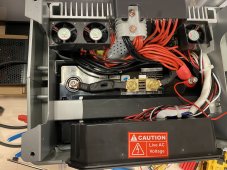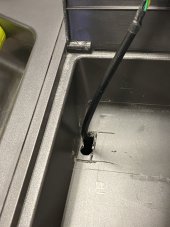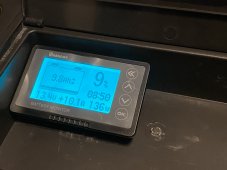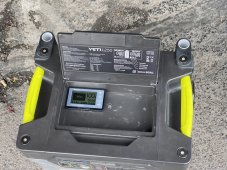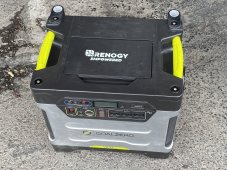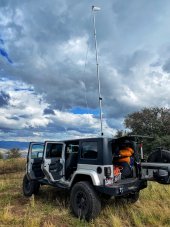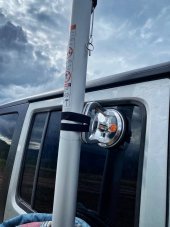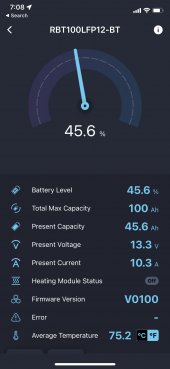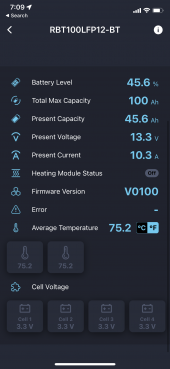What’s This Post About?
I got the portable, LiFePO4-based solar generator I wanted by combining an old-school Goal Zero Yeti 1250 with a Lion Energy Safari UT battery.
This is not the best system for everyone, but it fits my requirements almost perfectly. It’s also straightforward to achieve:
- Buy a used Goal Zero Yeti 1250.
- Buy a Lion Energy Safari UT LiFePO4 battery.
- Replace the lead-acid battery with the LiFePO4 battery.
- Enjoy your full featured, high capacity, portable LiFePO4 solar generator.
For those who want more of the story, read on.
Background
I wanted a portable, relatively large capacity, lithium-based solar generator that had room for expansion. In looking at the full-sized offerings on the market I found I didn’t really love the big Li-NMC systems. My concerns were fewer max capacity cycles, lack of easy expansion, and battery chemistry safety compared to LiFePO4. I looked to see if any vendors offered a LiFePO4-based system but didn’t find anything I liked. I figured I’d have to go the route of others and build my own portable system (I’m amazed at how cool the systems in Show and Tell are). Then I remembered a solar generator I had first looked at way back in 2012 but always dismissed as not truly portable: the lead-acid Goal Zero Yeti 1250.
Go here for Goal Zero Yeti 1250 info
The Conversion to LiFePO4
The Yeti 1250 is a monstrously heavy 103 lbs (46.7 kg) unit with a group 27 100Ah AGM lead-acid battery at its core. The good news is that
Goal Zero designed this system to have a user-replaceable battery. The battery accounts for over 60 lbs of the Yeti 1250’s weight, so I thought if I found a LiFePO4 drop-in replacement that was light weight and could fit in the battery compartment I might have something to work with. (The original battery measures 12.9" x 6.8" x 8.7".)
Enter the Lion Energy Safari UT 1200. Coming in at 21 lbs and offering more effective capacity than the lead-acid it would replace, I figured it would make the Yeti 1250 light enough to lift and make it actually portable (where my definition of portable is that I can lift it myself and put it into a vehicle for remote use). The Safari UT physical dimensions of 10.2” x 6.6” x 8.8” seemed workable in theory. In practice, it fits and has worked great so far.
Replacing the battery was straightforward, and Goal Zero even provides a seven-step procedure in the user manual. Here’s a
YouTube video of how to replace the battery.
After replacing the battery, the whole system weighs about 60 lbs.
Charging
- The old Yeti 1250 has a 20A MPPT charge controller built in! And unlike the MPPT module Goal Zero sells now for their Li-NMC models, you can put 12V panels in series because the input is rated at 16-48V (the Yeti Lithium 25A MPPT module input is rated at 15-22V which means you will be putting your 12V panels in parallel).
There are two types of charging ports, (2) 10A 8mm and a 20A Anderson power pole port for a combined input power rating of 240W.
[The website (320W) and manual (240W) have conflicting information, so I contacted Goal Zero customer support to confirm what the actual max input wattage is. The answer is max input of 240W, regardless of whether that all comes in through the Anderson power pole input or split between that and the 10mm input ports.]
- You can also use the chaining port (described below) to jack in whatever charge controller/charger you want. I use this to connect a Samlex 30A grid-power charger. I may also use it for a higher rated MPPT charge controller down the road.
State of Charge Monitoring
Note: I haven’t yet decided what I’m going to do long-term for state of charge monitoring since I assume the built-in monitor is calibrated for lead-acid. Stay tuned.
(Edit: Dec 21, 2019) First attempt at SoC monitoring is to use
this Drok meter with hall effect sensor. (More details
below.)
(Edit: June 9, 2020)
The Drok is a bust as it does not provide accurate SoC. I'll work on a shunt-based solution.
Output Ports
- 1200W continuous/1500W surge AC inverter (pure sine wave) with three outlets
- 3 – USB (2.1A)
- 2 – 6mm 12V DC (6A)
- 1 – Cigarette lighter style 12V DC (10A)
- 1 – Anderson power pole 12V DC (33A)
Expandability
The Yeti 1250 has a built-in chaining port (Anderson SB175 connector) on the back that allows users to add additional batteries in parallel. Perfect! I can attach more Safari UTs if I need to get more run-time, and since they only weigh 21 lbs a piece I can still load the whole setup into my SUV in pieces and reconnect at my destination. With the Anderson connector, adding or subtracting the additional batteries is a snap.
(Edit Mar 6, 2020) Example of chaining extra batteries can be seen
in this post below.
Availability
- Yeti 1250 – Find a used one on eBay. Goal Zero customer support told me that they have discontinued the Yeti 1250 (shortly after I bought a refurbished one from them).
- LiFePO4 Battery – Buy a Lion Energy UT 1300 (or any LiFePO4 battery that fits the dimensions stated above. Or go the DIY LiFePO4 route).
Note: Lion Energy discontinued the UT 1200 shortly after I bought a couple. Hmm, a pattern. The universe seems to be trying to tell me something. However, they are replacing it with a UT 1300 that is the same physical size, only 23 lbs, and reportedly will be 105 Ah (vs. 90 Ah for the 1200)
The Cost
Your mileage will likely vary from mine, but here it is for reference:
- Yeti 1250 - $700 for an “open box” Yeti 1250 from Goal Zero. I was able to sell both the lead-acid battery, and the Yeti roll cart (you may want to keep this depending on your situation) which brought my cost down to $550.
I’ve seen used Yeti 1250s sell on eBay for between $475-$650 recently.
- Safari UT 1200/1300 – $650 for a UT 1200 from Costco’s recent clearance sale. This is an atypically low price, so you will likely spend closer to $800-900 for a battery that fits into the compartment.
Drok meter for SoC monitoring - $29 (Edit: June 9, 2020) Don't buy the Drok.
- Chaining cable for extra battery capacity - $25 on eBay for a 2’ long 4 AWG cable: eBay chaining cable
Total cost for my base system:
$1,200 $1229 (Edit: Dec 21, 2019)
For reference, that is virtually identical to a Goal Zero Lithium (NMC) Yeti 1000 w/MPPT module.



